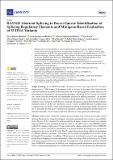Por favor, use este identificador para citar o enlazar a este item:
http://hdl.handle.net/10261/260858COMPARTIR / EXPORTAR:
 SHARE SHARE
 CORE
BASE CORE
BASE
|
|
| Visualizar otros formatos: MARC | Dublin Core | RDF | ORE | MODS | METS | DIDL | DATACITE | |

| Título: | RAD51D Aberrant Splicing in Breast Cancer: Identification of Splicing Regulatory Elements and Minigene-Based Evaluation of 53 DNA Variants |
Autor: | Bueno-Martínez, Elena CSIC ORCID CVN; Sanoguera-Miralles, Lara CSIC ORCID CVN; Valenzuela-Palomo, Alberto CSIC; Lorca, Víctor; Gómez-Sanz, Alicia; Carvalho, Sara; Allen, Jamie; Infante, Mar CSIC ORCID; Pérez-Segura, Pedro; Lázaro, Conxi; Easton, Douglas F.; Devilee, Peter; Vreeswijk, Maaike P. G.; Hoya, Miguel de la; Velasco, Eladio CSIC ORCID | Palabras clave: | Breast cancer Ovarian cancer Susceptibility genes RAD51D ESE ESS Aberrant splicing VUS Minigene Clinical interpretation |
Fecha de publicación: | 2021 | Editor: | Multidisciplinary Digital Publishing Institute | Citación: | Cancers 13(11): 2845 (2021) | Resumen: | RAD51D loss-of-function variants increase lifetime risk of breast and ovarian cancer. Splicing disruption is a frequent pathogenic mechanism associated with variants in susceptibility genes. Herein, we have assessed the splicing and clinical impact of splice-site and exonic splicing enhancer (ESE) variants identified through the study of ~113,000 women of the BRIDGES cohort. A RAD51D minigene with exons 2–9 was constructed in splicing vector pSAD. Eleven BRIDGES splice-site variants (selected by MaxEntScan) were introduced into the minigene by site-directed mutagenesis and tested in MCF-7 cells. The 11 variants disrupted splicing, collectively generating 25 different aberrant transcripts. All variants but one produced negligible levels (<3.4%) of the full-length (FL) transcript. In addition, ESE elements of the alternative exon 3 were mapped by testing four overlapping exonic microdeletions (≥30-bp), revealing an ESE-rich interval (c.202_235del) with critical sequences for exon 3 recognition that might have been affected by germline variants. Next, 26 BRIDGES variants and 16 artificial exon 3 single-nucleotide substitutions were also assayed. Thirty variants impaired splicing with variable amounts (0–65.1%) of the FL transcript, although only c.202G>A demonstrated a complete aberrant splicing pattern without the FL transcript. On the other hand, c.214T>C increased efficiency of exon 3 recognition, so only the FL transcript was detected (100%). In conclusion, 41 RAD51D spliceogenic variants (28 of which were from the BRIDGES cohort) were identified by minigene assays. We show that minigene-based mapping of ESEs is a powerful approach for identifying ESE hotspots and ESE-disrupting variants. Finally, we have classified nine variants as likely pathogenic according to ACMG/AMP-based guidelines, highlighting the complex relationship between splicing alterations and variant interpretation. | Descripción: | © 2021 by the authors. | Versión del editor: | http://dx.doi.org/10.3390/cancers13112845 | URI: | http://hdl.handle.net/10261/260858 | DOI: | 10.3390/cancers13112845 | E-ISSN: | 2072-6694 |
| Aparece en las colecciones: | (IBGM) Artículos |
Ficheros en este ítem:
| Fichero | Descripción | Tamaño | Formato | |
|---|---|---|---|---|
| RAD51D_Bueno_PV_Art2021.pdf | 1,81 MB | Adobe PDF |  Visualizar/Abrir |
CORE Recommender
PubMed Central
Citations
6
checked on 11-abr-2024
SCOPUSTM
Citations
10
checked on 26-abr-2024
WEB OF SCIENCETM
Citations
10
checked on 27-feb-2024
Page view(s)
30
checked on 30-abr-2024
Download(s)
44
checked on 30-abr-2024

